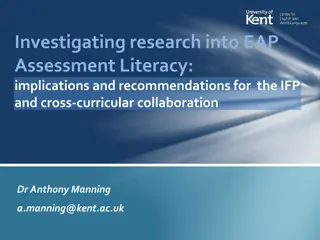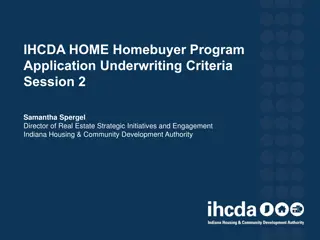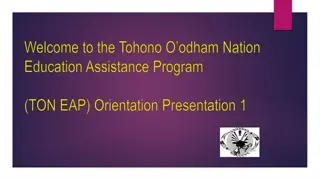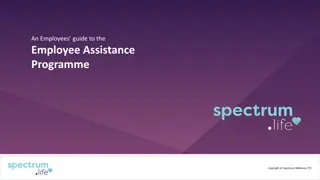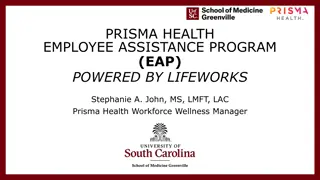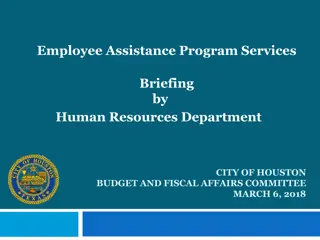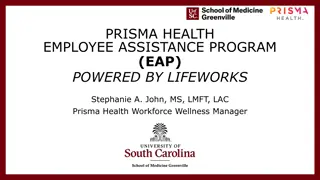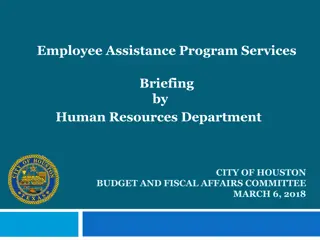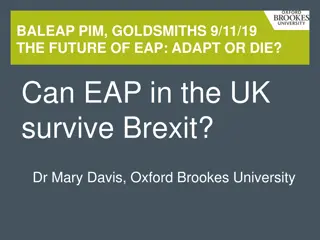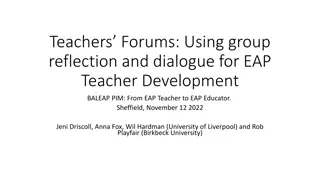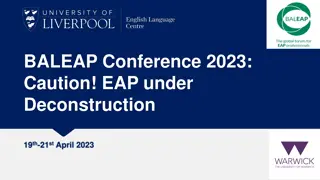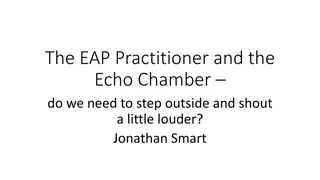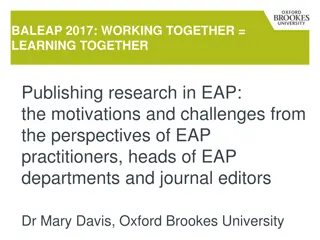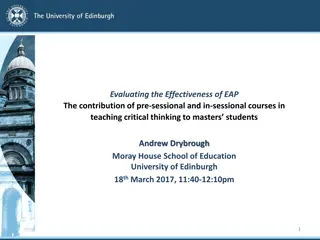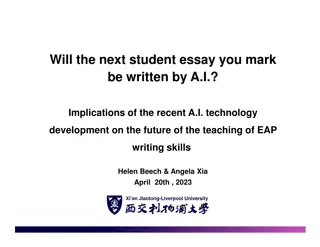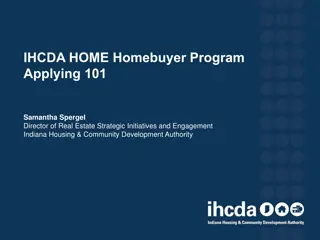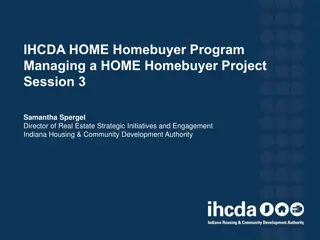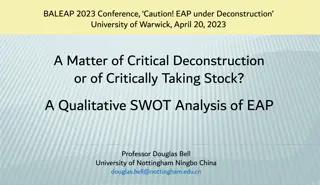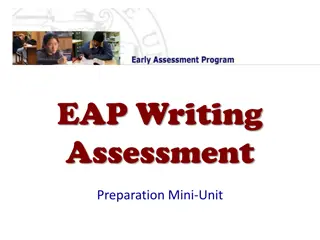IHCDA EAP Operations Updates and Changes Summary
Updates and changes in IHCDA's Energy Assistance Program (EAP) operations include transitioning to EAPConnect, enhancing online applications, contract guidelines, and vendor agreements. Important details about EAPConnect, federal compliance, vendor MOAs, and transmittals are highlighted for efficient program management. Stay informed about the latest developments to ensure smooth operations and compliance with guidelines.
Download Presentation

Please find below an Image/Link to download the presentation.
The content on the website is provided AS IS for your information and personal use only. It may not be sold, licensed, or shared on other websites without obtaining consent from the author.If you encounter any issues during the download, it is possible that the publisher has removed the file from their server.
You are allowed to download the files provided on this website for personal or commercial use, subject to the condition that they are used lawfully. All files are the property of their respective owners.
The content on the website is provided AS IS for your information and personal use only. It may not be sold, licensed, or shared on other websites without obtaining consent from the author.
E N D
Presentation Transcript
PY2021 IHCDA EAP Operations Thomas Hartnett-Russell Community Programs Manager 1
AGENDA 1. Operations Updates 2. Policy Changes 3. Changes to Forms 2
ONLINE APPLICATIONS IHCDA will be moving forward with transitioning from RIAA to EAPConnect. Roeing is providing intensive training across a series of five webinars. Roeing is enhancing EAPConnect to make it even more robust and user- friendly. RIAA will still be available, but LSPs are expected to make every effort to transition fully to EAPConnect this year. 4
EAPCONNECT EAPConnect is Roeing s web-based interface. It is accessible from any computer without a local RIAA installation. It is fully integrated with RIAA. Any changes processed in RIAA will be uploaded into EAPConnect servers on a daily basis. 5
CONTRACTS In order to promote compliance with federal guidelines and better accountability with our fiscal team, we will likely be issuing separate agreements and award balances for various types of funds (e.g., reallotment, carryover, regular 2021 award). IHCDA will offer additional guidance and support as these funding streams become available. We are not likely to know our full PY2021 funding until Spring of 2021. We anticipate beginning the year with a Continuing Resolution that will provide an equal amount of funding to 2020. 6
VENDOR MOAS All vendors signed new MOAs in 2019. Because we use two-year MOAs, no new MOAs will need to be completed unless it is a new vendor or a vendor that did not participate in PY2020. If you are aware of a vendor in your area that has not signed an MOA with us, please have them contact liheap@ihcda.in.gov in order to have an MOA sent to them. We are trying to eliminate paper MOAs. Effective PY2020, IHCDA will no longer be entering into MOAs with wood vendors or other biofuel providers. LSPs may develop their own MOAs in order to pay biofuel vendors directly using a voucher system. 7
TRANSMITTALS IHCDA asks that transmittals sent to vendors electronically. Avoid using regular mail to send transmittals, unless this is the only way a vendor can receive them. Please ensure that you are notifying IHCDA of these exceptions. All claims must be transmitted to vendors within 10 business days of claim approval. IHCDA asks all LSPs to adhere to a weekly schedule at minimum for both transmittals and submission of signed transmittals to IHCDA Fiscal. 8
LSP EMAIL Agencies are strongly encouraged to have a generic email where they can accept documents, applications, and questions or requests for information. IHCDA EMAIL There is a generic email for EAP. Agencies should use the IHCDA mailbox for general correspondence, questions about guidance, sending back budget modifications, questions, etc., rather than e-mailing the manager or analysts directly. LIHEAP@IHCDA.IN.GOV 9
CARES ACT LSPs were administered CARES Act funding in the late spring to assist households that were impacted by the COVID-19 pandemic. This funding expires on September 30, 2021, and is therefore still available to be drawn down by LSPs. There will be a separate presentation on the CARES Act agreement. 10
STATEWIDE APPLICATION There is a new two-page (front and back) application that is mandatory for all LSPs. IHCDA has also provided a Spanish language version of the application this year. IHCDA encourages fillable EAP applications to be sent to an email account. We will allow LSPs to fill out applications over the phone without obtaining a client signature, but notes must be made in the Statewide database. The Statewide database will no longer require applicants to fill out their full social security number. The first 5 numbers will be x s on the form. Should have your agency s logo and contact information at the top. 11
DATES The LSP must make a timely and accurate determination of the household's eligibility for benefits within the timeline below: For appointments: Ten (10) business days of the application's completion. For mail-ins: Fifty-five (55) calendar days of received date. The time frame starts November 1. Any application received before November 1, 2020 would have to be processed within 55 calendar days of November 1. Dates are defined as follows: Received date: The date an application is received by the LSP. LSPs must date stamp all incoming mail in applications when received. These applications should be processed on a first-received, first-serve basis. 12
DATES IN EAPCONNECT Application Date: the date stamp of the application. Application Entered: the day that the application was entered into the database. Completion date: The day that the application was completed. This will be mandatory when the client has a claim pending. 13
CLOSED ACCOUNTS An EAP benefit can be applied to a closed account if the client received the pledge or benefit before the account was closed. An EAP benefit cannot be applied if the funds are pledged or transmitted to the vendor after the client has closed the account. Vendors should NOT apply EAP benefits to closed accounts with a balance. Benefits should only be award to accounts that are indicated to be scheduled for closure or in final bill status if such a benefit will result in the account being reinstated and service continued at the address of record. 14
EXAMPLE Ex: A client closed an electric account and declared bankruptcy after submitting a mail-in application. The LSP transmitted a benefit 5 days after the account was closed. The electric company didn t catch that the account was closed when checking the transmittal and the transmittal was approved. When the funds were paid to the electric company, the company applied the funds to the outstanding balance. The company should have rejected the benefit on the transmittal. If it got through the transmittal process, the vendor should have sent the entire benefit back to IHCDA. 15
INDIVIDUAL CHECKS LSPs must make every effort to have clients who receive a direct payment benefit sign up for ACH/Direct Deposit. IHCDA will continue to print and mail the checks and initiate direct deposits. If a biofuel client is in crisis and needs an immediate benefit, and the LSP does not enter into MOAs with biofuel vendors, the LSP may issue the client an immediate crisis benefit and submit a claim for reimbursement. The LSP must include a list of clients who received a crisis benefit with the claim submission. For clients who have utilities included in their rent, the threshold of monthly rent paid required in order to be eligible for a benefit has been lowered to $1.00. 16
LSP ADMIN The Admin line item in LSP budgets is changing. LSPs will be able to charge 7.5% of their total expenditures to admin, and 2.5% of total award to Direct Program Expenses. There will be a separate presentation to review this change in more detail. 17
CRISIS BENEFIT CHANGES Beginning in PY2020, when determining benefit for an approved applicant who is in crisis, the LSP is to consider the disconnection or reconnection amount and award crisis first to that amount, up to a maximum of $200. Heating and electric utilities are each eligible for up to $200 in crisis benefits, for a total of $400. Unused crisis from one utility may not be waived to the other. Clients who heat with electric are eligible for crisis of $400 ($200 to the base electric, $200 to the portion of electric that provides heating fuel). Crisis for bulk fuels and biofuels should be given up front. Clients may come back once after initial application approval to use any crisis funding not used at the time of approval. 19
WOOD AND BIOFUELS Wood and other biofuels receive 11 points, and are eligible for $200 crisis. Crisis should be given up-front, and may not be waived to the electric utility. IHCDA is not entering into agreements with wood vendors this year. All wood clients will receive a check or an ACH deposit which they will use to purchase their wood on the market. LSPs may enter into agreements with local wood vendors at their discretion. If a client is in immediate need of wood, the LSP may issue a check in the amount of $200 to satisfy the immediate need with the crisis benefit. These claims are to be submitted to IHCDA for reimbursement. All regular benefits will be paid by IHCDA, unless LSP has entered into MOA with local vendors. 21
CONFIDENTIAL APPLICATIONS Any application in which any member of the household is an LSP employee, governing board member, sub-contractor, or a relative of any such persons requires special handling. Relatives include spouses, siblings, parents, grandparents, in-laws of the above, children, grandchildren, aunt, uncles, nieces, and nephews. All confidential applications must be received and processed by the LSP s EAP Manager or an appropriate supervisory-level designee, undergo a quality assurance review by a supervisor-level staff who is not related to the recipient of the benefits and was not involved in determining eligibility, and be reviewed by the LSP s Executive Director, Human Resources Director, or Board President. The Application is Confidential checkbox must be checked in the statewide database. 22
DRASTIC LOSS OF INCOME May be used if there is a sudden loss of earnings during the three-month period prior to application. May be applied in cases such as a plant or business closing, company downsizing, government employee furlough, or lost employment income due to a medical condition that prohibits employment. Does not apply to self-employment, the difference between part-time wages and what one would have received for full-time wages, or household members who lose employment due to voluntary resignation or involuntary resignation for cause. Documentation required in the form of a statement from the employer, union, or workforce development. This has been expanded during the state of emergency related to the pandemic and will be reviewed in another presentation. 23
EMERGENCY REPAIR AND REPLACE All service territories must offer ERR services to clients, either directly or through a partnership. LSPs may choose whether to institute a $5,000 per household cap, or ensure that the average benefit per household does not exceed $5,000. If contractors are performing the assessment, that contractor may not bid on the job. The assessment must indicate the reason why a repair or replacement was recommended. ERR claims are to be recorded in RIAA. LSPs may pay contractors directly and submit claim for reimbursement through IHCDA Online. 24
EMERGENCY REPAIR AND REPLACE IHCDA ERR Checklist and documentation of warranty for both labor and materials are required. Applicant is not to be made responsible for arranging for quotes, estimates, assessments, or actual work. Routine maintenance measures may not be paid for using ERR. If a furnace is assessed to be functioning but the LSP feels there is a compelling health and safety issue to justify replacement, the LSP must contact IHCDA for clearance. 25
EMERGENCY SERVICES Emergency Services claims must be tied to a natural disaster, catastrophic weather event, or medical emergency requiring the use of electrical medical equipment in the home. Weather events must be documented through official determination by the National Weather Service or other appropriate source. Benefits must be awarded within 30 days of qualifying event. Having a large disconnection notice due to continued nonpayment does not by itself constitute qualification for this benefit. Emergency Services may not be used as an additional crisis benefit in the absence of a qualifying disaster, weather, or medical event. Please contact IHCDA with any questions or requests for exceptions. 26
REFERRAL FORMS New requirement as of PY2020. At a minimum, must include all other income-based programs administered by LSP. May also include income-based programs administered by community partners. Information on programs applicant is interested in should be sent with EAP notification letter. Referral form must include release statement and place for signature and date. Referral form is to be included as a standard part of LSP s application packet and available for download on LSP s website. Signed, completed referral form is to be uploaded into the statewide database. If it is not returned, LSP may indicate that in case notes. 27
HOUSEHOLD ELIGIBILITY VS. BENEFIT ELIGIBILITY Intake staff must take care to distinguish between household eligibility and benefit eligibility. If a household has a requirement that is preventing the awarding of a benefit (e.g., inoperable equipment, outstanding deposit on account, etc.), this does not impact the determination of overall household eligibility. Household eligibility may be used to determine eligibility for other resources and can qualify households for moratorium protection. When household resolves issues preventing benefit payment, household eligibility must not be redetermined. Households must not be denied on the basis of not submitting utility bill documentation. 28
STATEWIDE APPLICATION FORM Slightly streamlined language on the form. Only require last 4 digits of SSN for HOH. Added employment status for each household member as required by CSBG Report Module 4. IHCDA is providing a Spanish-language version of the application this year. 30
REQUEST FOR EARNINGS INFORMATION This form can be used to report three months of earnings when an applicant household member is otherwise unable to obtain documentation of wages earned. If this form is used, it must be filled out in its entirety by a representative of the employer. This form has been edited to better capture eligibility of Drastic Loss of Income policy and CARES Act eligibility. 33
APPENDIX A - LIST OF MANUAL CHANGES Please refer to Appendix A in the manual for a list of changes. 35


